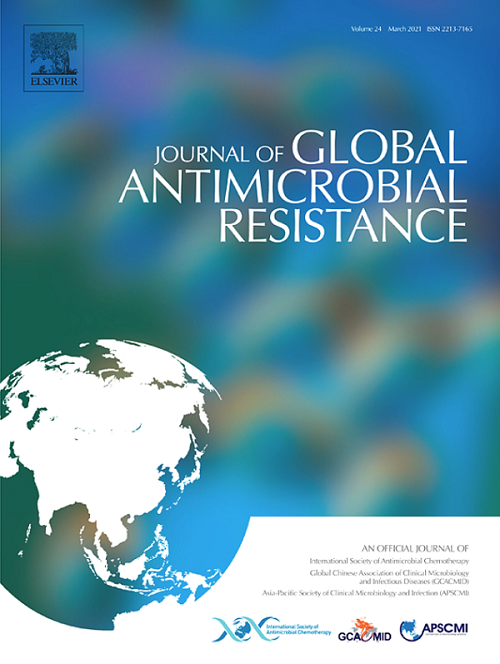Acinetobacter indicus Coharboring Tet(X6) and blaNDM-1 Isolated From Slaughterhouse Waste
IF 3.7
3区 医学
Q2 INFECTIOUS DISEASES
引用次数: 0
Abstract
Objectives
Acinetobacter indicus is an important pathogen of nosocomial infection. The purpose of this study was to analyze the resistance and transmission of A. indicus strain AIBD14 isolated from slaughterhouse environment.
Methods
A total of 96 environmental samples were collected from slaughterhouse. The antimicrobial susceptibility test was carried out by microbroth dilution method and E-test. Whole genome sequencing and bioinformatics analysis of the AIBD14 were performed, then S1-PFGE and southern blot verified the location of blaNDM-1 and tet(X6).
Results
The AIBD14 is resistant to meropenem but susceptibility to tigecycline, and coharboring blaNDM-1 and tet(X6). The blaNDM-1 is located on the pAIBD14-NDM-1 that cannot be transferred by conjugation. Specifically, blaNDM-1 is located on the transposon Tn125, and blaNDM-1 can be transferred to other species with the help of transposon. The genetic background of blaNDM-1 is "ISAba125-blaNDM-1-bleMEL-dsbD-cutA-groES-groEL-insE-ISAba125". pAIBD14-NDM-1 is classified into the GR31 plasmid based on the homology of the repB. Meanwhile, there are two XerC/D-like binding sites on the plasmid, which can mediate the transfer of resistance genes. The tet(X6) gene is located on the chromosome of AIBD14, its downstream is accompanied by the neglected macrolide resistance gene estT, and there is a single copy of the insertion element ISCR2 around tet(X6) as the genetic background "ISAba4-IS3-hp-hp-tet(X6)-estT-guaA-ISCR2".
Conclusions
This is the first report of the coexistence of tet(X6) and blaNDM-1 in the A. indicus, and it has the risk of horizontal transfer across multiple species. So strict monitoring the multiple-resistant bacteria in the industrial chain is necessary based on the "One Heath".
从屠宰场废弃物中分离出的带有 tet(X6)和 blaNDM-1 的靛蓝不动杆菌。
目的:indicus不动杆菌是医院感染的重要病原体。本研究的目的是分析从屠宰场环境中分离到的印度伊蚊AIBD14菌株的耐药性和传播情况。方法:在屠宰场采集环境样本96份。采用微肉汤稀释法和e试验进行药敏试验。对AIBD14进行全基因组测序和生物信息学分析,然后进行S1-PFGE和southern blot验证blaNDM-1和tet的位置(X6)。结果:AIBD14对美罗培南耐药,对替加环素敏感,同时携带blaNDM-1和tet(X6)。blaNDM-1位于不能通过偶联转移的pAIBD14-NDM-1上。具体来说,blaNDM-1位于转座子Tn125上,blaNDM-1可以借助转座子转移到其他物种。blaNDM-1的遗传背景为“ISAba125- blaNDM-1- blemel - dsbd - cuta - groes - groel - inse -ISAba125”。基于与repB的同源性,pAIBD14-NDM-1被归入GR31质粒。同时,质粒上有两个XerC/ d样结合位点,可以介导抗性基因的转移。tet(X6)基因位于AIBD14染色体上,其下游伴随被忽视的大环内酯类耐药基因estT, tet(X6)周围有一个单拷贝的插入元件ISCR2,遗传背景为“ISAba4-IS3-hp-hp-tet(X6)-estT-guaA-ISCR2”。结论:本文首次报道了tet(X6)和blaNDM-1在籼稻中共存,且具有跨种水平传播的风险。因此,在“一个健康”的基础上,严格监控产业链上的多重耐药菌是必要的。
本文章由计算机程序翻译,如有差异,请以英文原文为准。
求助全文
约1分钟内获得全文
求助全文
来源期刊

Journal of global antimicrobial resistance
INFECTIOUS DISEASES-PHARMACOLOGY & PHARMACY
CiteScore
8.70
自引率
2.20%
发文量
285
审稿时长
34 weeks
期刊介绍:
The Journal of Global Antimicrobial Resistance (JGAR) is a quarterly online journal run by an international Editorial Board that focuses on the global spread of antibiotic-resistant microbes.
JGAR is a dedicated journal for all professionals working in research, health care, the environment and animal infection control, aiming to track the resistance threat worldwide and provides a single voice devoted to antimicrobial resistance (AMR).
Featuring peer-reviewed and up to date research articles, reviews, short notes and hot topics JGAR covers the key topics related to antibacterial, antiviral, antifungal and antiparasitic resistance.
 求助内容:
求助内容: 应助结果提醒方式:
应助结果提醒方式:


